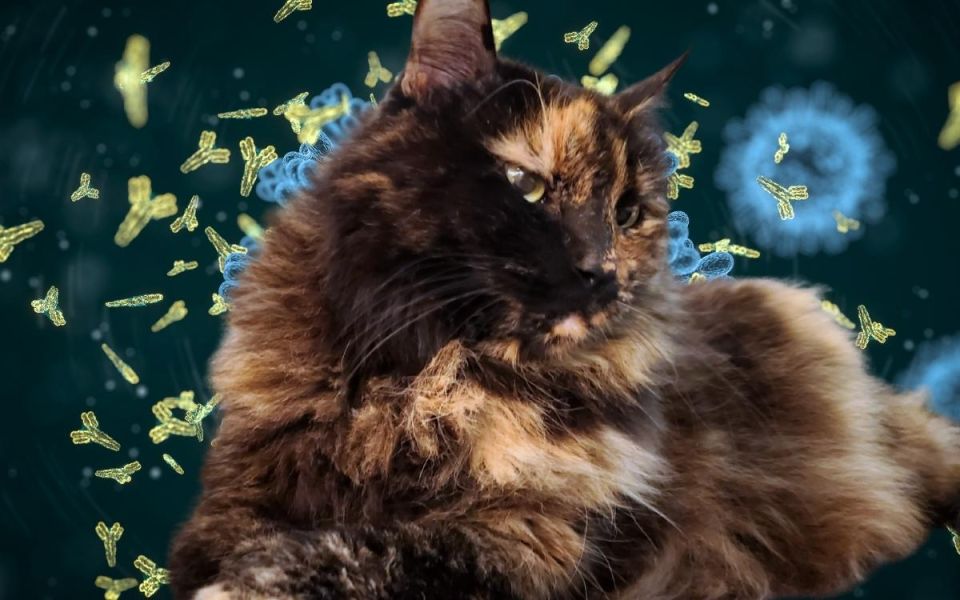What My Cat Taught Me About Monoclonal Antibodies

I have a cat who is very prim, sassy, prissy, and picky about food. We have tried feeding her dry food, wet food, fancy food, cheap food, and a combination of dry and wet food, but she refuses to eat anything except tuna. She’s like a laser, picking out only the tuna among a plethora of alternatives. Actually, she’s more like a monoclonal antibody, picking out only one antigen from a myriad of options. But what are monoclonal antibodies, how do they work, and what makes them special?
To understand monoclonal antibodies, we must first understand antibodies in general. Antibodies are proteins in the body that play a key role in detecting and neutralizing dangerous items.[1,2] The general structure of an antibody looks like a Y.[2]
The top of the Y, which has two arms, or prongs, contains both the light chain and a portion of the heavy chain.[2] Each prong of the upper antibody is made of unique protein subunits responsible for recognizing and binding to antigens on bacteria, substances, or cells targeted to be destroyed.[1,2]
The bottom of the Y, the long stick, is the Fc region and contains most of the heavy chain.[1,2] This region is also known as the “effector region” because it is the part that causes an effect (such as an immune response).[1,2] The Fc region may attach to or interact with immune cells, activate destructive processes, block pathogens from entering cells, and/or perform other defense-related functions.[2] The light chain serves as the recognizer (like my cat’s nose), while the Fc region/heavy chain is the part that makes something happen (like my cat’s mouth).
When we have an infection, the body’s immune system produces a wide variety of antibodies, each specialized to recognize and bind to its target.[1] This can be very helpful because different antibodies can attach to other parts of the same invader or to secondary invaders - it's like when I put out five different types of dry cat food to try to get Miss Priss to eat.[1] Each specific antibody is made by a distinct immune cell, and together this diversity creates a polyclonal response. This is great in normal circumstances, but it means that every polyclonal mix of antibodies is different.[1] In medicine, we want high amounts of control to limit side effects and make sure we are hitting the correct target. Since each antibody-producing immune cell makes just one type of antibody, scientists can create identical copies (clones) of antibodies that will only attach to a specific target.[1] Scientists do this by using the cells that make specific antibodies to make clones of just one type, monoclonal antibodies.[1]
Modern science and medicine is interested in more than just mimicking normal antibodies, though, and scientists have engineered antibodies to do many specific tasks. They have altered the heavy chain of antibodies to:[1,3,4]
- Stain and identify cells
- Directly kill cells, for example, by attaching to a cell and activating deadly enzymes
- Block cells or toxins from entering tissue
- Create an immune response
- Mark an otherwise “invisible” cancer cell so the immune system can find and destroy it
- Directly deliver a drug (e.g., for cancer) to only specific cells
This is amazing technology that has opened new avenues to otherwise very difficult-to-treat diseases, like blood cancers and autoimmune disorders.[4] Additionally, this technology has allowed for previously unprecedented levels of personalization in medicine, where doctors and medical teams can provide specific monoclonal antibodies to achieve specific results with fewer side effects than would otherwise be possible. So keep your eyes and noses out for clinical trials looking at these personalized monoclonal antibodies, and one day you may be as pampered in medicine as my cat is in tuna.
Creative Director Benton Lowey-Ball, BS, BFA
|
Click Below for ENCORE Research Group's Enrolling Studies |
|
Click Below for Flourish Research's Enrolling Studies |
References:
[1] Nelson, P. N., Reynolds, G. M., Waldron, E. E., Ward, E., Giannopoulos, K., & Murray, P. G. (2000). Demystified…: monoclonal antibodies. Molecular pathology, 53(3), 111. https://pmc.ncbi.nlm.nih.gov/articles/PMC1186915/
[2] Betts, J. G., Young, A., Wise, J. A., Johnson, E., Poe, B., Kruse, D. H., Korol, O., Johnson, J. E., Womble, M., & DeSaix, P. (2013). 21.4 The adaptive immune response: B-lymphocytes and antibodies. OpenStax. https://openstax.org/books/anatomy-and-physiology/pages/21-4-the-adaptive-immune-response-b-lymphocytes-and-antibodies
[3] Bayer, V. (2019, October). An overview of monoclonal antibodies. In Seminars in oncology nursing, 35(5), 150927. https://doi.org/10.1016/j.soncn.2019.08.006
[4] Tsao, L. C., Force, J., & Hartman, Z. C. (2021). Mechanisms of therapeutic antitumor monoclonal antibodies. Cancer research, 81(18), 4641-4651. https://aacrjournals.org/cancerres/article-abstract/81/18/4641/670332/Mechanisms-of-Therapeutic-Antitumor-Monoclonal


